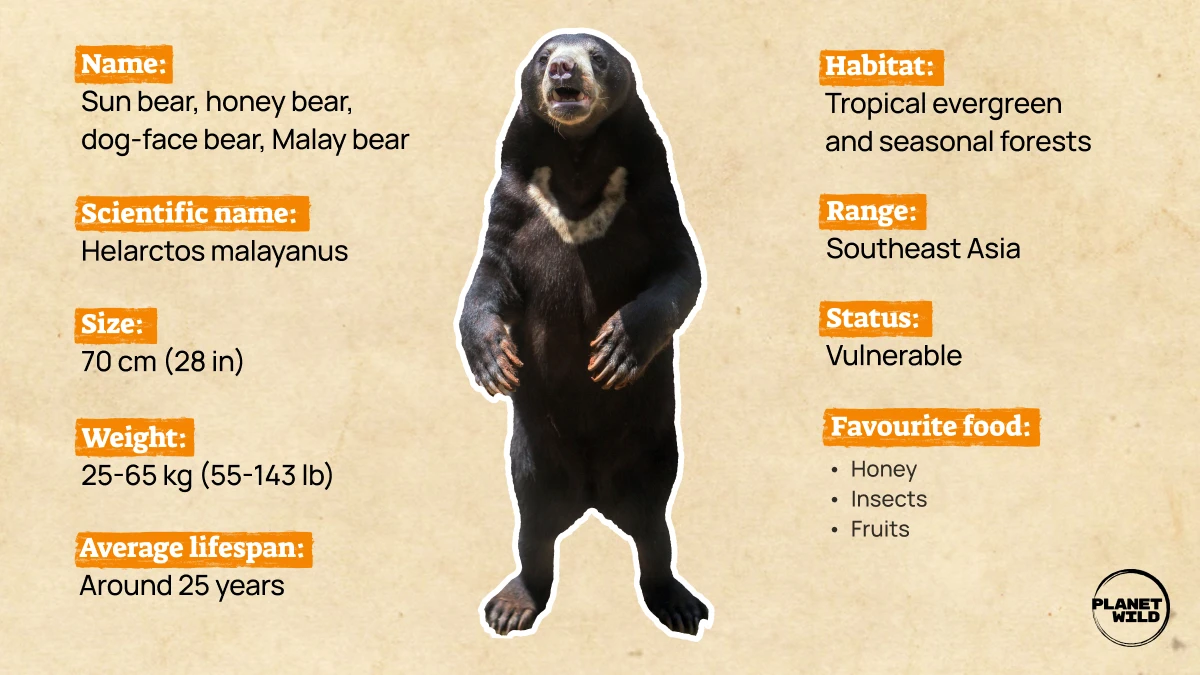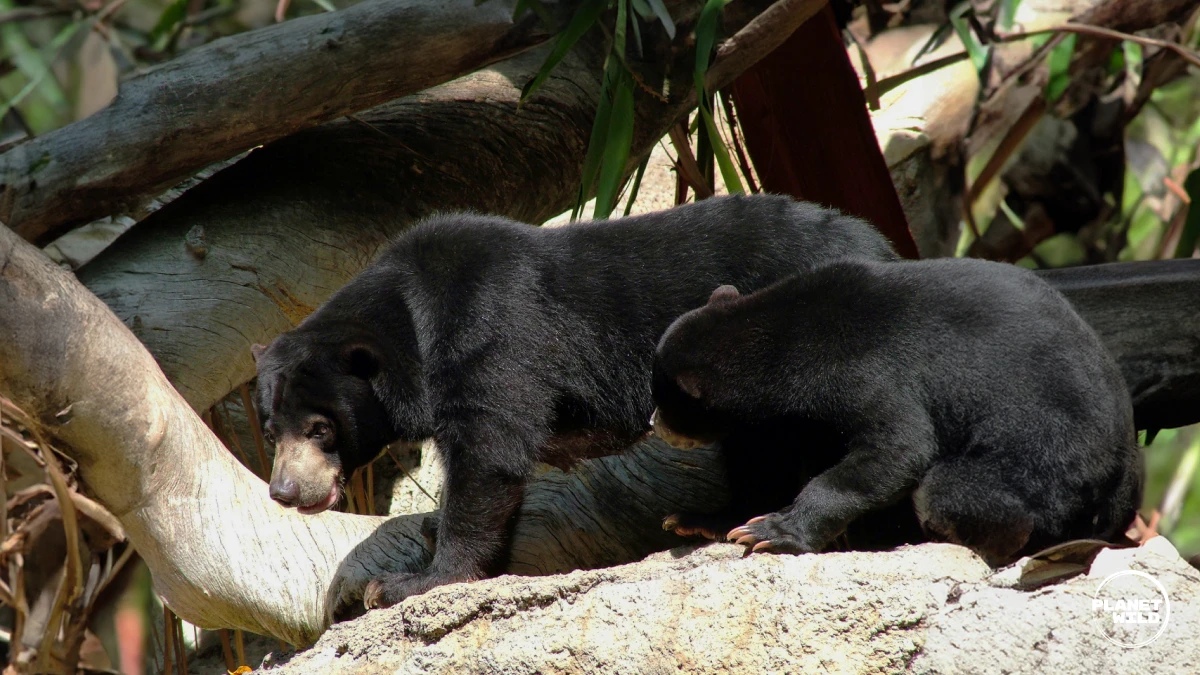Sun bears: The world’s smallest and most vulnerable bear

The sun bear is the smallest (and arguably cutest) of the world’s 8 bear species. Standing only as tall as an average human woman, there are less than 10,000 of these forest-dwelling bears left in the wild. Their biggest threats come from poachers, who hunt them for traditional medicine, meat, and the illegal pet trade, as well as extensive habitat loss.

Native to the tropical forests of Southeast Asia (India, Bangladesh, Indonesia, Borneo, Sumatra, etc), sun bears love nothing more than climbing trees and foraging on the forest floor for insects, small invertebrates, seeds, and fruits. They are best known as the world’s smallest bear, but also shiest.
As these adorable little bears are arboreal (tree-living), and spend much of their time high up in the canopy which keeps them safe from danger during the day. Despite their name, these little bears are actually nocturnal, and use the cover of darkness to hunt down a meal before returning to the treetops for the day.
What do sun bears eat?
While sun bears are omnivores and will eat pretty much anything they can get their paws on, their favorite food by far is honey. They have an incredible sense of smell—2000 times more powerful than ours—which they use to sniff out the hives. They use their sharp claws and a super long tongue to rip open hives and scoop out the delicious sweet treat inside. As a result, sun bears are often called honey bears. Their uniquely long tongue can reach up to 30 centimeters (12 inches) long, which allows them to reach deep into crevices to find food.

Their tiny size has a number of benefits. It allows them to defy gravity and climb up to 40 feet into the canopy—higher than any other bear species. Their large paws and flexibility allow them to traverse the treetops with ease, making them act more like monkeys than bears!
Sun bear characteristics: What do they look like?
What makes sun bears so recognizable is their crescent-like patch of golden fur on their chest. Some say this resembles the rising sun. While we don’t know for sure why they have this unique chest patch, one theory is that it serves as a warning sign to other animals. Sun bears are small, standing at only 70cm, which is about the same size as an average human woman, and about half the size of a U.S. black bear.
Despite being 10 times smaller than their cousin the polar bear, they actually both have the same sized teeth. They are also known to stand on their hind legs like people, either to check out their surroundings or to intimidate their enemies by displaying the chest patch if threatened.

There are two kinds of Sun bears found in Southeast Asia. The Himalayan sun bear can be found on the Asian mainland and Sumatra, but the Bornean sun bear subspecies can only be found in Borneo. The difference between them is size, snout, and fur type. Himalayan sun bears have longer and thicker fur, with a light brown muzzle-shaped nose. The Bornean sun bear has shorter and smoother fur, and a wider nose.
Sun bear family life
Sun bears are reclusive and shy, and little is known about their lives. We do know that they are solitary animals, but can occasionally be seen in pairs (such as a mother and a cub). Sun bear cubs are born completely hairless and helpless, and completely rely on their mothers for food, warmth, and protection.
Baby sun bears are carried around by their mother for about 2 months after birth. Mothers have been seen walking on their hind legs while carrying their cub in their arms. Babies stay by her side for about 2 years before they head out on their own. The bears reach sexual maturity around 3-4 years old, and can breed all year round.

Are Sun bears endangered?
Sun bears are considered vulnerable, with anywhere between 1000 and 10,000 left in the wild, however there are no conclusive numbers. Sadly, sun bears now occupy just 32% - 40% of their historical South Asian range, and are at risk of extinction unless urgent conservation action is taken.
The main threats to the bears are deforestation and commercial hunting. Sun bear bile is used in traditional medicine and their paws, teeth, bones, and other body parts sell for lots of money on the black market. Sun bear meat is a delicacy in some parts of the world. Even more upsettingly, poachers will regularly steal cubs to sell as part of the exotic pet trade. Despite being highly illegal, the practice is still common. Sun bears are often rescued by conservation teams in Southeast Asia, such as the Bornean Sun Bear Conservation Centre we partnered with in our most recent mission.

Since sun bears spend most of their time climbing trees, they rely on lush, dense rainforests and a large forest environment. However, much of this habitat has now vanished as a result of increasing human activity, like the mass production of palm oil, logging, and urban expansion. As a result, the bears have lost up to 60% of vital rainforest habitat making it harder for them to survive and keep the population strong.
5 things you didn’t know about sun bears
Sun bears don’t hibernate
Unlike other bear species, sun bears don’t need to hibernate through the winter. The reason is that food is abundant year-round in their tropical rainforest environments, so they don’t need to spend cold winters conserving energy.
They are a keystone species

Sun bears are a keystone species, and are considered ecosystem engineers in the forests they call home. In their hunt for wood-dwelling insects, sun bears often rip cavities and holes in deadwood and trees which become important habitats for other forest species, such as the endangered Hornbill and other birds. They are also crucial to nutrient cycling and seed dispersal through their varied diet and waste.
Sun bears engage in facial mimicry
An exciting 2019 study uncovered that, like humans and gorillas, sun bears use facial mimicry to communicate with each other! Humans use facial mimicry to express empathy for others, as well as express nonverbal information. The study concluded that sun bears use distinct open-mouthed expressions during play, which could be to express more play or to strengthen social bonds.
The oldest sun bear lived to 34
Dresena, the world's oldest known sun bear, was put to sleep at a Tucson Zoo in 2015. The elderly female was brought to the zoo in 2001, and lived almost a decade longer than her wild counterparts. Another sun bear, named Tsuyoshi, also made it to the ripe old age of 32 in Japan. In human years, both these sun bears lived well into their 90s.
They build nests!

Much like birds, sun bears like to build cozy nests high up in the canopy to sleep and sun bathe during the day. They build their nests high up in the treetops, just like orangutans. This keeps them and their young safe from predators. The nests usually consist of a pile of tree branches and twigs that are bent at a tree fork close to the main trunk. It is unclear if sun bears reuse their nests, but it’s more likely they just build a new one when necessary.
Sun bears are vital to the rainforests they call home. Not only are they cute, they’re key to the success of their ecosystem. With so few left in the wild, it’s more important than ever to protect this vulnerable species from becoming extinct.
About Planet Wild
Planet Wild is committed to rewilding the planet through monthly missions that work directly with grassroots organizations dedicated to fighting the biodiversity crisis. When you become a Planet Wild member, your contribution will directly fund innovative and exciting projects all over the world, so you can make a difference from home. Learn more about what we do here.
Sources & Further Reading
Bear-ly on the Radar: Indonesia’s Illegal Sun Bear Trade, The Radar
Sun bear guide: where they live, what they eat and the threats they face, Discover Wildlife
Siew Te Wong's Sun Bear Journal